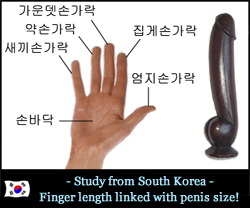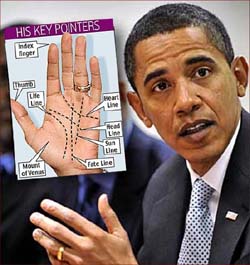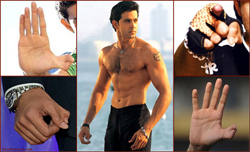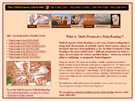Hand of hope… or just a (primitive) reflex?
September 14, 2013
In 1999 a report was published about a boy (Samuel Armas) that grasped his surgeon’s hand from a hole in his mother’s uterus during open fetal surgery for spina bifida.
The story became an internet hit and in september 2011 the story became hyped again due to a controversy because it was used by opponents of abortion who asserted that the baby reached through the womb and grabbed the doctor’s hand, thus showing signs of life at the 21st week of pregnancy.
A hand of hope… or just a (primitive) reflex?
Doctors have reported that it is not unusual for babies in this position to reach out to the world, and during a spina bifida surgery both the mother and the fetus are under anesthesia – which implicates that both can not move.
The truth is that any grasping ‘hand of hope’ in likewise conditions can best be described as nothing but a simple primitive reflex (a.k.a. a palmar reflex), which are automatic reflex actions of the body originating in the central nervous system. This implicates that such apparent ‘reflexes’ should not get confused with conscious behavior.
What you might want to know about:
Primitive reflexes of the hand!

 The human opposable thumb: with reason neurologist Frank R. Wilson called it ‘the Twenty-Four-Karat thumb’. Because thumb studies in primates have revealed that only humans have ‘perfect opposable thumbs’. But there is more, because new evidence indicates that the opposable thumb has a direct correlation with self-awareness in the primate family!
The human opposable thumb: with reason neurologist Frank R. Wilson called it ‘the Twenty-Four-Karat thumb’. Because thumb studies in primates have revealed that only humans have ‘perfect opposable thumbs’. But there is more, because new evidence indicates that the opposable thumb has a direct correlation with self-awareness in the primate family!
Scientists say that there are two things that have given rise to man’s dominance as a species: one is the opposable thumb, the other is self-awareness. Interestingly, scientists also developed a test to assess ‘self-recognition’ (which is in psychology known as a first milestone in the development of self-awareness in young children) via the so-called ‘mirror test’.
The video below shows how this ‘mirror test’ has also been used to assess the capability for self-recognition in primates. And the table below displays a strong correlation between self-recognition and the opposable thumb in the primate family tree (+ a the bottom a picture is presented summarizing the hand characteristics seen in the listed primate species).
SOURCE: Opposable thumbs & self-awareness!

 The primate hands family tree shows how dominant behavior in primates can be linked with hand structure. For example, gorillas & baboons are known to belong to the most dominant/aggressive primate species and both species have a hand structure that is different from other primate species!
The primate hands family tree shows how dominant behavior in primates can be linked with hand structure. For example, gorillas & baboons are known to belong to the most dominant/aggressive primate species and both species have a hand structure that is different from other primate species!
It is rather fascinating to see that both species (gorilla + baboon) actually have a hand structure that reminds us of the typical hand differences seen between males and females, incuding: short fingers, broad palms & a low 2D:4D digit ratio.
These biological & evolutionary patterns appear to explain why in nearly all primate species males tend to dominate females. Except for the bonobos of course, females tend to collectively dominate males by forming alliances and use sexuality to control males – interestingly, a few years ago a study reported that bonobos have a rather human-like 2D:4D digit ratio (close to 0.94)… which is illustrative for their rather high emotional intelligence. The Bonobo-society has been described as ‘extraordinarily peacefull’.
This illustrates that Sir Charles Bell was very right about the hand representing capacity, and modern science has still a long way to go in order to understand properly how the structure of the hand corresponds with behavior!
More details:
http://www.handresearch.com/news/primatology-palm-reading-primate-hands-family-tree.htm
The fate of a violin player resides in their pinky finger!
February 11, 2013

Nina Lordi – Professional violinist.
The violin is known as the instrument most commonly offered to children by state schools in the UK. It’s a challenging instrument, because rapid independent motion of the digital joints in the left hand is desirable… and a requirement in order to become a top violin player! A brand new study focussed on the pinky finger was designed after an 11-year-old patient volunteered that she had given up playing the violin because of difficulty and discomfort manoeuvring the left small and ring fingers independently. On examination, she was found to have absent FDS (flexor digitorum superficialis) function in the small finger – a condition that can be found in about 6% of the general populaton.
Do you have the ‘flexor digitorum superficialis’?
You can test this right now at home (see also the video below): hold down the index, middle, and ring fingers of your left hand, then try to bend your little finger. Now try it again, but allow your ring finger to bend as well.
Can you do it?
The UK study revealed that about 18 percent of people can do neither!
However, in a group of 90 professional musicians from “three of London’s leading orchestras” (38 first violinists, 33 second violinists, 19 viola players), none lacked this ability, and all but two were able to bend just their pinky finger!!!
Via: The Atlantic
The Megan Fox thumbs ‘saga’ continues!
February 9, 2013
 Last december the Megan Fox thumb ‘saga’ continued at The Tonigh Show with Jay Leno, where Megan talked about her thumb insecurities (she has clubbed thumbs)… suggesting that she thinks her weird ‘fat’ thumbs are the result of her mom eating Tuna during her pregnancy of Megan!
Last december the Megan Fox thumb ‘saga’ continued at The Tonigh Show with Jay Leno, where Megan talked about her thumb insecurities (she has clubbed thumbs)… suggesting that she thinks her weird ‘fat’ thumbs are the result of her mom eating Tuna during her pregnancy of Megan!
Megan described:
‘What is weird to me is I was talking to my mom … and she was like, “Oh, I ate tuna every day when I was pregnant with you,” I was wondering if that was what happened to my thumbs. They’re weird and they’re really fat and there’s like a weird knuckle.’
Now that Megan has become a mom herself (in the summer of 2012 Megan wondered if she was maybe birthing a vampire baby like the one from ‘Twilight’), it is heartbreaking to see that she now has the guts to talk about her thumb insecurities. Hopefully, this will inspire other people having this physical anomaly to deal with feeling of shame!
TIP – Megan Fox thumb tribute!
(The episode was featured at VH1 & below you can find the YouTube video featuring Megan Fox interview in december 2012 at The Tonight Show with Jay Leno)
Earlier reports about Megan Fox’ toe tumbs:
• Actress Megan Fox has the clubbed thumb (BDD) – it’s a hereditary cosmetic defect! (2009)
• Megan Fox’ stubby thumbs replaced for Motorola Super Bowl commercial! (2010)
• Megan Fox has Obsessive Compulsive Disorder: what are the associated hand characteristics? (2010)
• Megan Fox’ thumb got Photoshopped in Armani Jeans & Underwear Campaign! (2011)
 Iran’s new finger-chopping machine may be touted as a punishment for thieves, but Mahmoud Amiry-Moghaddam (spokesperson for Iran Human Rights in Norway) thinks this cruel and unusual method of punishment is really just an attempt to crush political dissent!
Iran’s new finger-chopping machine may be touted as a punishment for thieves, but Mahmoud Amiry-Moghaddam (spokesperson for Iran Human Rights in Norway) thinks this cruel and unusual method of punishment is really just an attempt to crush political dissent!
Iran has unveiled its latest innovation in criminal punishment – a machine that cuts off the fingers of thieves. A series of photographs appearing to show a blindfolded man having his fingers severed by the mechanical amputation device, have been published latelly by an official Iranian press agency.
According to the INSA news service, the prisoner used to demonstrate the brutal contraption had been convicted of theft and adultery by a court in Shiraz last Wednesday. The series of pictures show three masked officials, clad entirely in black, holding the man’s right hand in a vice while one turns a wheel operating the guillotine in the manner of a rotary saw.
This warning, issued without explanation, is perceived by various authorities to deter public protest ahead of June’s general elections.
More impression from the published series of photographs is available at The Telegraph
Holding hands with a fetus – PART 2
January 18, 2013

ARIZONA, OCTOBER 2012
This remarkable photo was taken by Arizona’s Randy Atkins, who is a professional photographer. His wife Alicia gave birth to their daughter Neveah last October.
“The doctor called me over and said, ‘Hey, she’s grabbing my finger,'” Mr Atkins told Arizona’s 3TV News. “So I ran over there and just grabbed the shot and I was just in awe looking at it. It was such an amazing picture.”
The Atkins posted the photo on facebook and thanked obstetrician Dr Allen Sawyer.
By the way, doctors say that it is not unusual for babies in this position to reach out to the world. The story reminds us to an even more impressive story about a 22 week old fetus who made a likewise gesture in the year 1999 (see picture below):
Holding hands with a 21-week old fetus: the story of Samuel Armas

The Human Piano: ‘Living in Harmony’ (Amnesty International 2011-2012)
December 27, 2012
 In 2011 Amnesty International presented the ad campaign Human Piano playing ‘Living Harmony’. In november 2012 they launched a new Living in Harmony ad campaign that is aimed at sending a harmonious message to people about ‘Living in Harmony’ with each other.
In 2011 Amnesty International presented the ad campaign Human Piano playing ‘Living Harmony’. In november 2012 they launched a new Living in Harmony ad campaign that is aimed at sending a harmonious message to people about ‘Living in Harmony’ with each other.
Each finger in the Human Piano depicts a different personality that is highlighted with information about them and a link to the cause that they support.
Advertising Agency: Grey Istanbul, Turkey
You might want to play the Human Piano yourself, visit: humanpiano.org
(The video below demonstrates how the Human Piano can be used for various purposes)
The perils of keeping your hands & fingers to yourself!
December 8, 2012
Recent studies show that if you kept your fingers away from your face and out of your mouth-nose-eyes, you’d lower your risk of self-inoculating with opportunistic germs.
Cursing your sick colleague for the infection you can feel settling into your chest? You might want to aim the finger of blame closer to home. It’s entirely possible you may have infected yourself with whatever respiratory bug has latched onto your lungs. The same can be said about some of the stomach-wrenching gastrointestinal ailments people occasionally get.
People sometimes self-inoculate. They take germs they picked up on their hands when they were hanging onto bus poles and they deliver the bugs to places where those bugs can go from harmless to disease causing. They stick germ-coated fingers into their mouths, they rub their eyes, they are even known to poke a finger into a nostril.
Bug on skin becomes bug on mucus membrane – a much more porous surface and an easier route to a warm and welcoming place for the bug.
Handwashing and alcohol gels can slough those germs off your fingers. And that’s why public health officials repeat the handwashing mantra relentlessly.
But a group of researchers suggests there’s a part of the prevention equation that public health folks don’t stress often enough: If you kept your fingers out of your mouth-nose-eyes, you’d lower your risk of self-inoculating.
“People touch their faces, touch their mouths, pick their noses and all of that. And in those behaviours they can bring these viruses that are on their hands to the muscosa … where they can really infect us,” says Wladimir Alonso, an infectious diseases researcher at the U.S. National Institutes of Health’s Fogarty International Center.
Alonso and some colleagues wrote a letter to the Journal of Infectious Diseases recently to make the point. They had done a small study where they observed 249 randomly selected individuals in public spaces in Florianopolis, Brazil and on the Washington, D.C. subway system. The individuals they observed touched common surfaces and their mouth and nose area at a rate of 3.3 and 3.6 touches respectively an hour.
Their point? Handwashing alone can’t keep up with the infection potential of self-inoculation events. Or as they put it, ” … the opportunities for hand re-contamination in public settings occurs at a much higher rate than any viable hand washing frequency.”
They suggest public health campaigns should also teach people about how they infect themselves by touching their mucus membranes, so they become more aware of the role these behaviours could play in acquiring infection.
Dr. Jody Lanard likes the suggestion. A risk communications expert based in Princeton, N.J., Lanard monitors public health messaging about influenza closely, and says officials often overstate the benefits of handwashing.
That’s not to say Lanard doesn’t believe in handwash-ing. She is, in fact, a big fan of the practice. But she’d prefer it if authorities stuck to the science – and says there isn’t that much evidence handwashing cuts down on flu transmission. (That doesn’t mean it doesn’t, just that there aren’t a lot of studies showing that it does. )
Lanard thinks public health messaging should suggest that it’s plausible that frequent handwashing reduces the risk of acquiring colds and the flu.
The author of a book on hygiene says public health messages about handwashing and self-inoculation should be synergistic. “I don’t think it’s an either-or thing,” says Dr. Bonnie Henry, author of Soap and Water and Common Sense.
Henry is the medical director of communicable disease prevention and control services at the British Columbia Centre for Disease Control. She says it can be difficult to get people to think about self-inoculation.
“I think it’s inevitable that you’re going to touch your face and you really need to make sure that you clean your hands regularly because that’s what’s going to protect you at the end of the day.
“I always say, ‘It’s not having bugs on your hands that’s the issue. It’s when you go to eat your sandwich or rub your eye. That’s when you’re going to get sick from it.'”
Alonso says it’s important to keep the issue in context. He doesn’t want to turn people into hypochondriacs.
While people can self-inoculate, it isn’t going to happen every time a person puts a finger into their mouth or rubs the bottom of their nose.
That said, when there is a disease outbreak, such as a flu pandemic, having people aware of the role they can play in triggering their own infections could be helpful in slowing the spread of disease.
Via: The Windsor Star
Etiquette expert: ‘It’s fine to eat with your fingers, but don’t lick them clean!’
November 29, 2012

 Debrett’s has published new guidelines for eating with your hands:
Debrett’s has published new guidelines for eating with your hands:
‘FINGER FOOD: THE DOS AND DON’TS OF EATING WITH YOUR HANDS’
In our more informal times, it is acceptable to eat certain foods with your hands. The aim should be to create as little mess as possible.
1 – It is sensible to cut large items into manageable-sized pieces that can be supported with both hands. Always put the food down on your plate between bites.
2 – When eating with your hands it can be tempting to hunch over your plate. Try to sit up straight, don’t intrude into your neighbour’s space and never put your elbows on the table.
3 – If your food is too hot to touch it will be too hot to eat; avoid over-the-top blowing on your food to cool it down. Be patient.
4 – When eating with your hands, it is better to take plenty of small bites. This will avoid any excess mess or possible overspill of any filling. If the filling spills onto the plate, use your fork to eat it -don’t pick it up with your fingers.
5 – Make use of your napkin. Place your napkin on your lap, don’t tuck it into your shirt or collar. Wipe your hands as you need to, but remember it’s likely to be a bit messy. If your hands get food on them, try to avoid licking your fingers clean.
6- If you get food on your lips, dab the corners of your mouth with your napkin as necessary during the meal. Don’t make grand wiping gestures. When you’ve finished, leave your napkin unfolded beside your plate.
7- Never wipe your mouth with your hand or talk with your mouth full – even if you have a conversational gem up your sleeve.
8 – Even if all your fellow diners have chosen to eat with their hands, it is perfectly acceptable to use a knife and fork if you wish.
9 – Eating with your hands is a relaxed and convivial style of dining, but don’t let your standards slip. Remember your manners.
10 – Never use your phone at the table.
Via: DailyMail

 Finger length & penis size linked!
Finger length & penis size linked! The hands of Barack Obama
The hands of Barack Obama Megan Fox thumbs – TRIBUTE
Megan Fox thumbs – TRIBUTE Hrithik Roshan thumbs – TRIBUTE
Hrithik Roshan thumbs – TRIBUTE Hand Reading Research!
Hand Reading Research! MultiPerspective Palm Reading
MultiPerspective Palm Reading